Resveratrol downregulates TGF-β1 and Smad3 expression and attenuates oxidative stress in CCl4-induced kidney damage in rats
2020-08-05SaeedMohammadiJamshidKarimiHeidarTavilaniIrajKhodadadiRoohollahMohseniMohammadHashemnia
Saeed Mohammadi,Jamshid Karimi,2✉,Heidar Tavilani,Iraj Khodadadi,Roohollah Mohseni,Mohammad Hashemnia
1Department of Clinical Biochemistry.Hamadan University of Medical Sciences,Hamadan,Iran
2Nutrition Health Research Center,Hamadan University of Medical Sciences,Hamadan,Iran
3Clinical Biochemistry Research center,Basic Health Sciences Institute,Shahrekord University of Medical Sciences,Shahrekord,Iran
4Department of Pathobiology,Veterinary Medicine Faculty Razi University,Kermanshah,Iran
ABSTRACT
Objective: To evaluate the effect of resveratrol against CCl4-induced nephrotoxicity.
Methods: Forty-two male Wistar rats were divided into seven groups randomly.After six weeks,kidney weight,body weight,blood urea,serum creatinine,oxidative stress markers,and gene expression of renal transforming growth factor-beta1 (TGF-β1),TGF-β receptor type 1 (TGF-βR1) and Smad3 were determined.In addition,the protein level of TGF-β1 in the tissue lysate was measured.
Results: Resveratrol had a protective role in renal tissue by the improvement of antioxidant balance and reduction of renal parameters such as creatinine and urea (P<0.001).In addition,the renal mRNA level of TGF-β1,TGF-βR1,Smad3,as well as the protein level of TGF-β1 were decreased in rats treated with resveratrol (P<0.001),compared to the CCl4 group.
Conclusions: Overall,resveratrol shows a protective effect against nephrotoxicity in CCl4 treated rats by reducing oxidative stress status and modulating the TGF-β signaling.
KEYWORDS: Nephrotoxicity;Transforming growth factor beta1;Resveratrol;Carbon tetrachloride
1.Introduction
Kidney plays an important role in the homeostasis,regulation of the extracellular environment,detoxification and elimination of metabolites such as drugs from the body[1].Nephrotoxicity is a complication that is caused by exposure to toxins,consumption of some medications,and even the long-term use of food containing additives,which induces kidney filtration dysfunction[2,3].Chronic kidney disease is a major complication of nephrotoxicity[4,5].
Carbon tetrachloride (CCl4) is a compound without color and with volatile property[6].The previous study proved that exposure to CCl4leads to tissue damage and kidney injury through elevating reactive oxygen species[7].
TGF-β signaling pathway is involved in different cellular processes like cellular proliferation and differentiation,regulation and immune reactions[8].TGF-β as an important factor of chronic kidney disease induces progressive fibrosis in the kidney by the production of extracellular matrix components and prevention of decomposition of these elements[9].Furthermore,various studies reported the correlation of incidence of nephrotoxicity with high levels of TGF-β[10].
Natural antioxidants have useful features,including antiinflammatory,anti-aging and anticancer properties.Resveratrol is a part of polyphenolic compounds,which is found in grapes,red wine and berries[11].Many considerable evidences show that resveratrol prevents progression of the disease by various mechanisms such as the elimination of free radicals,anti-inflammatory and anti-cancer properties,and lipid metabolism regulation[12,13].
Recent data have shown the protective role of resveratrol against kidney damages[14].Therefore,in the present study,we evaluated the protective roles of resveratrol as a natural compound against nephrotoxicity and its underlying mechanism.
2.Materials and methods
2.1.Animals
Forty-two male Wistar rats (180-200 g) were kept at temperature 22-25 ℃ and 12:12-h light/dark cycles with a humidity of 45%-55%.All animals had free access to food and water.The rats were divided into seven groups randomly after the acclimatization period for 7 d in the animal house.Group one received a daily intake of normal saline at 2 mL/kg orally as healthy control.Group two received 1 mL/kg olive oil via intraperitoneal injection and served as vehicle control.Group three and four were treated with 1 mL/kg olive oil and 10 mg/kg or 20 mg/kg resveratrol,respectively.Group five and six received CCl4in 1 mL/kg olive oil solution and 10 mg/kg or 20 mg/kg resveratrol,respectively.Group seven as nephrotoxicity control received CCl4.The nephrotoxicity was induced via intraperitoneal injection of CCl4at 1 mL/kg (50% v/v,dissolved in olive oil) two times each week for 6 weeks.At the same time,a mixture of resveratrol (Mega Resveratrol®,USA) and distilled water was gavaged to each rat in the treated groups daily.Researchers were interested to find the best amount and dosage of resveratrol.Several doses of resveratrol have been examined in animal models.In our study,a low dose (10 mg/kg) and a moderate dose (20 mg/kg) were selected.
2.2.Ethical statement
Procedures of present work for the treatment of animals were approved with guideline principles for the care and use of animals at the Faculty of Medicine at Hamadan University of Medical Sciences(IR.UMSHA.REC.1396.322,11 July 2017).
2.3.Preparation of tissue and blood
After treatment for six weeks,all animals which were fasted overnight were weighed,anesthetized by 100 mg/kg ketamine and then sacrificed.After dissecting each rat through a incision on the abdomen,the kidneys were immediately removed,washed in icecold saline and weighed.Small pieces of the kidneys were cut and one piece was immersed in 10% neutral buffered formalin and fixed for histopathological observation.The other pieces were immediately frozen in liquid nitrogen and kept at -80 ℃ for future analysis.Sera were isolated and then stored in aliquots at -20 ℃ until further analysis.
2.4.Histopathological evaluation
The kidneys were instantly separated from animals.Then,the sections from the kidneys of each animal after fixation in 10%formalin solution were embedded in paraffin,cut into 5 μm thick slices and stained by hematoxylin-eosin (H&E) based on the previous protocols[15].
2.5.Serum biochemical analysis
Serum urea levels were measured by a commercial kit (Pars Azmoun Co,Iran).The production of ammonium by the urease enzyme that catalyzed the hydrolysis of urea was evaluated via the glutamate dehydrogenase coupled reaction system according to the manufacturer's instructions.Creatinine levels in serum were determined via Jaffe's reaction where creatinine associated with picric acid generates an orange color in alkaline condition,and the absorbance of color was quantified at 520 nm using a commercial kit(Pars Azmoon Co.,Tehran,Iran).
2.6.Oxidative stress analysis
Oxidative stress mediators and indicators were determined in the kidney tissue homogenate.Total antioxidant capacity (TAC)levels in the tissues were evaluated based on the ferric-reducing antioxidant potential assay.The mechanism of total oxidant status(TOS) measurement is based on the oxidation of ferrous ion to ferric ion under the acidic condition.For lipid peroxidation assay,malondialdehyde (MDA) was measured by thiobarbituric acid(TBA) reaction.Thiol groups were measured by spectrophotometric methods based on the reaction of SH groups with 2,2-dithiobis nitrobenzoic acid.Catalase activity was analyzed based on the ability of samples for the catalyzing of hydrogen peroxide as a substrate.
2.7.Enzyme-linked immunosorbent assay (ELISA)
The protein level of TGF-β1 in the tissue lysate was assessed by using rat TGF-beta1 ELISA kit (ab119558,Abcam,MA,USA)based on the manufacturer's datasheet.
2.8.Gene expression analysis
Total RNA was isolated from frozen kidney tissue using an RNXPlus kit (Cinnagen,Tehran,Iran) using the manufacturer's manual catalog.The quality and quantity of extracted total RNA were identified using a nanodrop 2000 spectrophotometer (Thermo Fisher Scientific Inc.,Wilmington,USA).The first-strand cDNA was synthesized using the cDNA synthesis kit (TaKaRa Biotechnology,Tokyo,Japan).
Quantitative PCR was carried out using the SYBR Green master mix (Amplicon,Denmark) in the LightCycler®96 instruments(Roche Life Science Deutschland GmbH,Sandhofer,Germany).Primers were designed using primer blast software and presented in Table 1.PCR reactions were carried out in triplicates and the 2-ΔΔctformula was applied to calculate the gene expression in the control and treatment groups.β-actin was used as the internal control gene.
2.9.Statistical analysis
Statistical tests were performed via SPSS 16 software (IBM,USA).The results were presented as mean ± standard deviation.Statistical significance was estimated by one-way analysis of variance (ANOVA).Statistically,P-values less than 0.05 were regarded as significant.
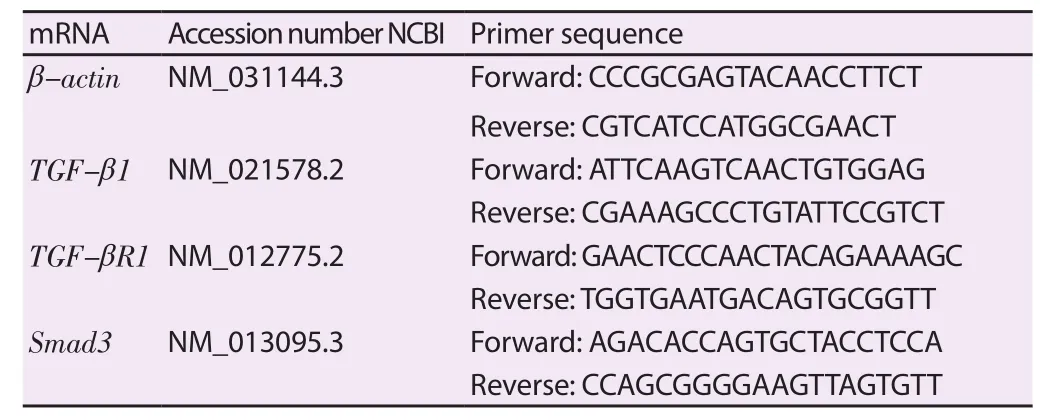
Table 1.The sequences of primers used in qRT-PCR.
3.Results
3.1.Histopathological observations
On histopathological examination,the morphology of proximal and distal convoluted tubules,glomerular tufts and bowman capsules were normal in the kidneys of the healthy control group.The morphology of these structures in normal rats treated with 10 mg/kg and 20 mg/kg resveratrol was similar to the healthy control group.Administration of CCl4for 6 weeks led to moderate to severe tubular degeneration and necrosis characterized by eosinophilic cytoplasm with many vacuoles and pyknotic nuclei as well as the presence of the detached epithelial cells from the basal membrane,hypocellular glomeruli with degenerative and epithelial necrotic changes,congestion of glomerular tufts,infiltration of mononuclear cell in the interstitial tissue and intraluminal protein casts.Furthermore,the apparent increase in the thickness of Bowman's capsules,cortical tubule,glomerular atrophy and expansion of Bowman's space were seen.
Treatment of CCl4-intoxicated rats with resveratrol showed changes such as moderate degeneration and necrosis in the tubular and glomerular epithelium,slight infiltration of mononuclear cell in the interstitial tissue and mild glomerular congestion.Tubular epithelial atrophy and the thickness of Bowman's capsules were considerably lower in the CCl4-intoxicated rats treated with 10 and 20 mg/kg resveratrol in comparison with the CCl4group.There was no sign of cytoplasmic vacuolations in the tubular epithelium.The high dose of resveratrol markedly improved structural effects on the damaged kidneys (Figure 1).
3.2.Body and kidney weights
CCl4significantly reduced the weight of rats in the nephrotoxicity group.Resveratrol at 10 and 20 mg/kg reversed the changes induced by CCl4.Moreover,CCl4significantly increased kidney weight in comparison with the healthy control group while resveratrol treatment markedly reduced the kidney weights (Table 2).
3.3.Biochemical parameters
CCl4intoxication for 6 weeks significantly elevated serum levels of urea and creatinine compared to the healthy control group.These parameters were decreased by resveratrol treatment and kidney filtration function was thus improved (Table 2).
3.4.Oxidative stress biomarker
The CCl4group elevated the renal MDA level and TOS level and reduced the renal TAC,thiol and catalase activity compared with the healthy control group (P<0.001).In contrast,resveratrol at 10 and 20 mg/kg treatment suppressed the renal TOS and MDA as well as increased considerably the renal TAC,thiol and catalase activity in the CCl4-intoxicated rats (P<0.001) (Figure 2).
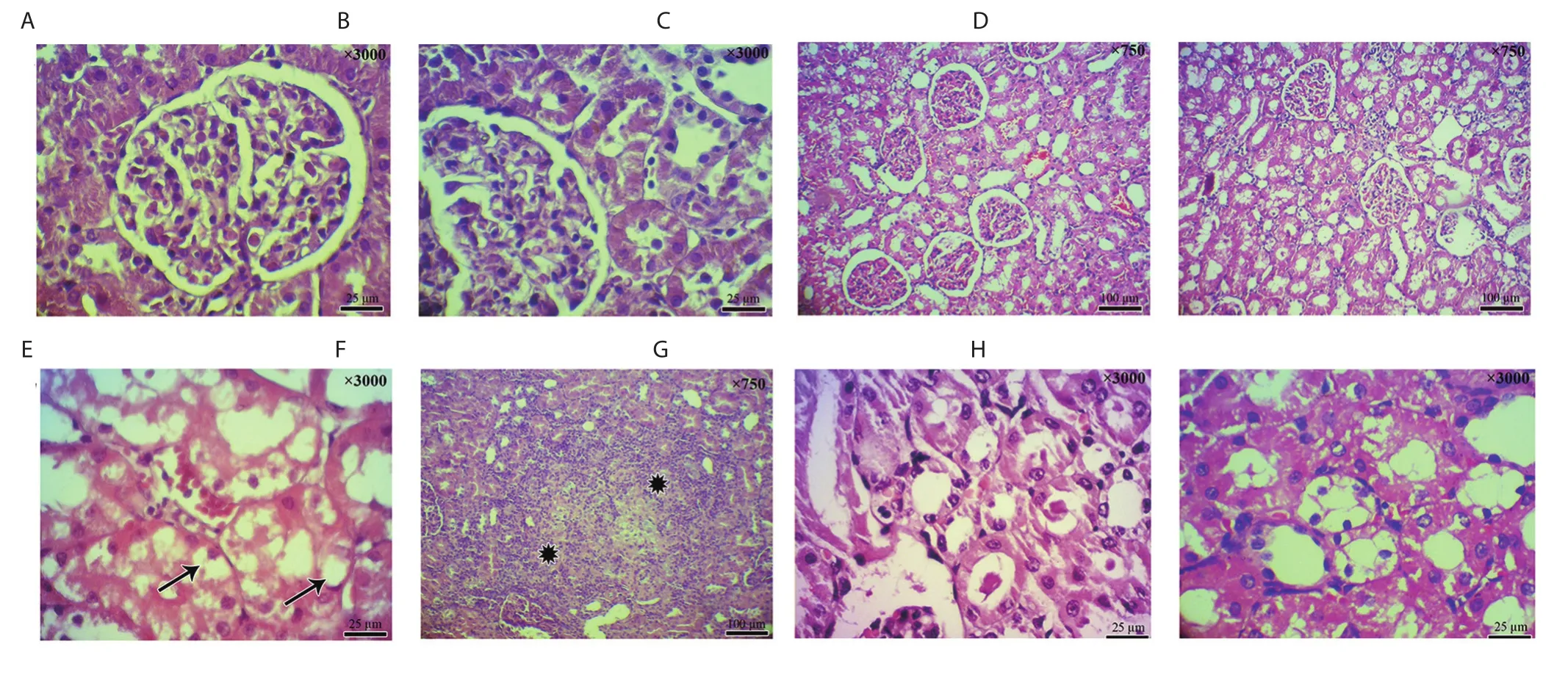
Figure 1.Histological sections of kidney from normal rats,CCl4 intoxicated rats and CCl4 intoxicated rats treated with resveratrol (H&E staining;A,B,E,G,H,at ×3 000 magnification,and C,D,F at ×750 magnification).Normal renal histoarchitecture with well-organized tubules and normal glomerulus and Bowman's capsule is observed in (A) healthy control,(B) olive oil,(C) olive oil + resveratrol 10 mg/kg,and (D) olive oil + resveratrol 20 mg/kg groups;(E) The CCl4 group shows severe tubular degeneration and necrosis accompanied with cytoplasmic vacuoles (arrows),and (F) severe infiltration of mononuclear cell in the interstitial tissue (stars);(G) The CCl4 intoxicated rats treated with 10 mg/kg resveratrol show mild tubular atrophy without cytoplasmic vacuoles;(H) The CCl4 intoxicated rats treated with 20 mg/kg resveratrol show well-organized proximal and distal convoluted tubules which is comparable with the normal group.
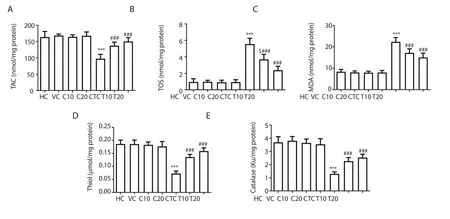
Figure 2.Effect of resveratrol treatment on the renal oxidative stress parameters.A: total antioxidant capacity (TAC);B: total oxidant status (TOS);C:malondialdehyde (MDA) level;D: thiol level;E: catalase activity.HC: Healthy control;VC: Vehicle control (olive oil alone);C10: Olive oil + Resveratrol 10 mg/kg;C20: Olive oil + Resveratrol 20 mg/kg;CTC: CCl4 control;T10: CCl4 + Resveratrol 10 mg/kg;T20: CCl4 + Resveratrol 20 mg/kg;***P<0.001 compared with the healthy control;###P<0.001 compared with the CCl4 group;$P<0.001 compared with the resveratrol treatment at 20 mg/kg in CCl4 intoxicated rats.
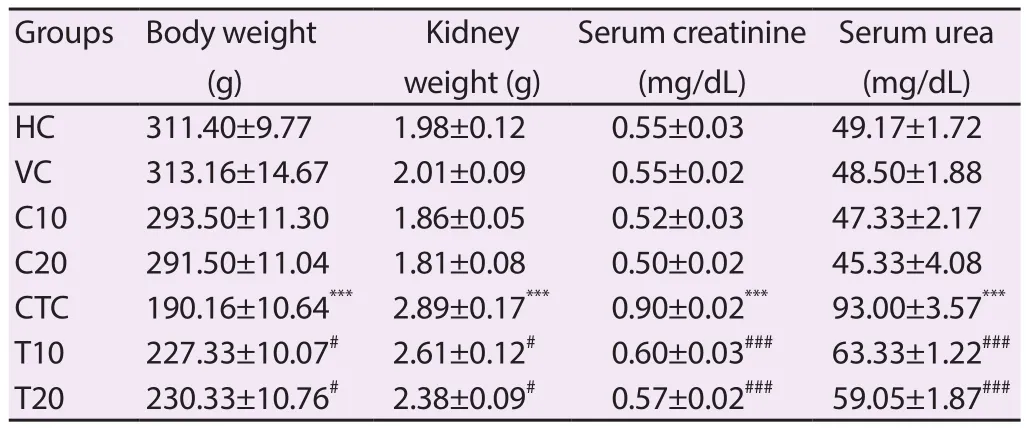
Table 2.Effect of resveratrol on body/kidney weights and serum biochemical markers.
3.5.Renal TGF-β1 protein levels
The TGF-β1 protein levels of the CCl4group in kidney tissues were significantly increased (P<0.001).However,both doses of resveratrol reduced protein levels in CCl4intoxicated rats (Figure 3).
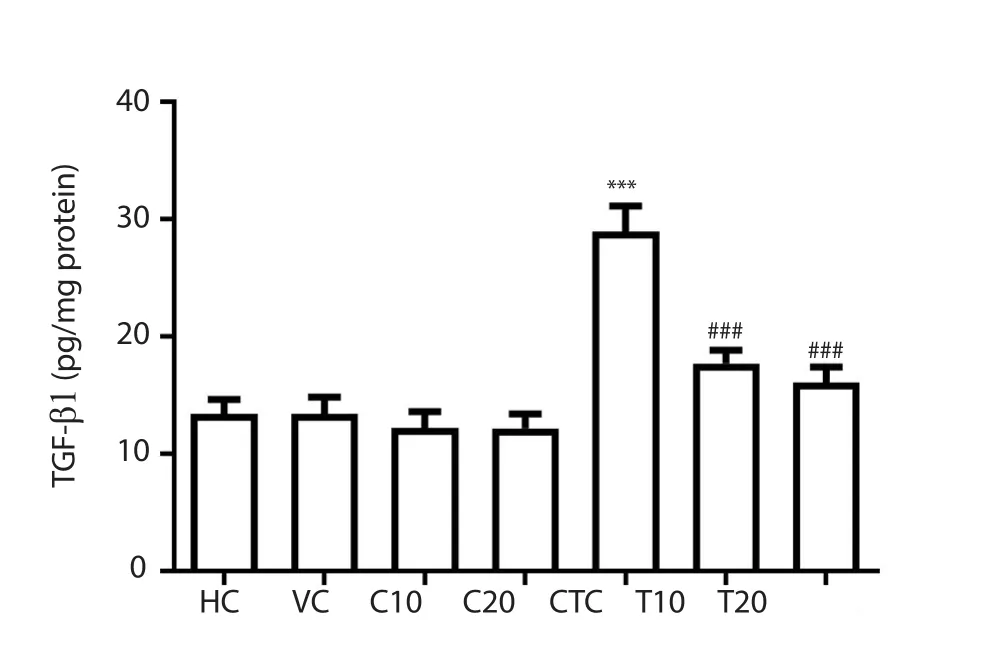
Figure 3.The protein level of TGF-β1 in kidney tissues.***P<0.001 compared with the healthy control;###P<0.001 compared with the CCl4 group.
3.6.Gene expression
In the CCl4control group,significantly high mRNA levels of TGF-β1,TGF-βR1,and Smad3 were observed.However,these levels were downregulated by both doses of resveratrol,showing the protective effect against nephrotoxicity induced by CCl4(Figure 4).
4.Discussion
The kidney is the main organ of the body which eliminates waste disposal[10].Chemicals and drugs cause nephrotoxicity that increases mortality and morbidity all over the world.Previous studies showed that exposure to CCl4causes nephrotoxicity through generating reactive oxygen species[16].These radicals will be attached to the proteins and lipid membrane,which leads to protein degeneration,lipid membrane peroxidation,and DNA oxidative damage,causing tissue damage[7].
In order to evaluate the glomerular filtration,the urea of serum is measured[17].In the present study,CCl4increased urea amount and affected glomerular cells,which led to the reduction of kidney filtration.Whereas,resveratrol decreased the serum urea and improved the glomerular filtration rate by preventing the damages to glomerular cells.In 2007,a study conducted by de Jesus Soares et al.revealed that resveratrol reduces serum urea and improves the glomerular filtration of rats with nephrotoxicity induced by glycerol[18],which is in line with our results.Creatinine is filtered in the kidney's glomeruli and is considered as the kidney's performance indicator[19].The previous study showed CCl4exposure leads to an increase of the serum creatinine as a valuable marker of the kidney's function by affecting the glomerular filtration[20].Furthermore,the administration of resveratrol improved the kidney's performance and normalized the creatinine level[21].The present study showed that resveratrol improved CCl4-induced kidney damage,and significantly decreased the serum creatinine level.

Figure 4.Effect of resveratrol treatment on levels of (A) TGF-β1,(B) TGF-βR1,and (C) Smad3 mRNA in kidney tissue.***P<0.001 compared with the healthy control;###P<0.001 compared with the CCl4 group.
Disturbance of oxidative balance leads to many pathological disorders,such as nephrotoxicity,oxidative and molecular-cellular damage.The results of this study demonstrated that CCl4intoxication increased the oxidative stress status in the rats' kidney,which was in line with the previous study[22].The study of Yoshioka et al.reported that CCl4exposure induces oxidative stress in the kidney,evidenced by the high level of MDA and the reduction of antioxidant enzymes in kidneys[23].
According to our results,total oxidative status and the MDA level were increased while the catalase activity and the free thiol rate were decreased in CCl4intoxicated rats.Resveratrol reversed these changes,showing its protective effect.Reduced level of MDA indicates the role of resveratrol in preventing membrane lipid peroxidation.The study conducted by Al Dera[24]which indicated that resveratrol modulates the oxidative stress induced by chloride aluminum is in agreement with the findings of our study.Moreover,a study revealed that resveratrol improves the cell antioxidant enzyme activity in the kidney tissue of the gentamicin intoxicated rats[25].TGF-β is an extracellular cytokine that is involved in many different processes such as cellular development,wound healing,cell cycle regulation,cell replication,cell differentiation,blood cell production,and extracellular matrix formation[26].The main route of TGF-β,which arises from the cell membrane receptors,is the phosphorylation of the protected Smad proteins[27].Smad proteins are categorized into three groups: R-Smads proteins which are directly connected to the receptors and phosphorylated by TGF-βR1;Co-Smads which play a role of mediator in TGF-β cascade pathway;I-Smads as the inhibitor proteins of the TGF-β pathway.
Upon TGF-βR1 activation,R-Smads become phosphorylated and form heteromeric complex with Smad4.Afterwards,this complex transfers as a transcription factor,to the nucleus and then connects to the DNA[28].One of the main functions of the TGF-β is tissue repairment and tissue fibrosis,which regulates the extracellular matrix protein expression,such as collagen and fibronectin.TGF-β prevents the extracellular matrix protein decomposition through the increase of protease inhibitor expression,such as PALs and TIMPs[29].
Overexpression of TGF-β1 gene plays a crucial role in renal fibrosis[9].TGF-β1,in addition to the increase of extracellular matrix proteins,induces the process of epithelial-mesenchymal transition.In comparison with the epithelial cells,the myofibroblast cells play a key role in production of extracellular matrix in the normal and pathological conditions.The process of epithelialmesenchymal transition in tubular cells will lead to cell degeneration and fibrosis[30].In this study,gene expression and the protein level of TGF-β1 were increased in the CCl4-intoxicated rats,in comparison with the healthy control group.Resveratrol decreased the expression of TGF-βR1,and TGF-β signaling.
Smad proteins mediate the biological processes that relate to TGF-β1.Several fibrogenic genes,such as proteoglycans,integrin,tissue growth factors (CTGF),tissue inhibitors,metalloproteinase 1,collagen 1,collagen 6,collagen 5 and collagen 7,are the targets of the TGF-β1/Smad pathway[31].Smad3 has a central role in kidney fibrosis and Smad3 gene knockout in rats decreases kidney's tissue fibrosis[28,32].
In conclusion,resveratrol shows a protective effect against nephrotoxicity in CCl4treated rats by reducing oxidative stress status and modulating the TGF-β signaling.Resveratrol may be useful for remedy of kidney damages in future after clinical trial evaluations.More studies are required to reveal exact molecular mechanisms.
Conflict of interest statement
The authors declared no conflicts of interests.
Acknowledgments
The results presented in this article were from S.Mohammadi MSc thesis.
杂志排行
Asian Pacific Journal of Tropical Biomedicine的其它文章
- Antidiabetic effect of Chrysophyllum albidum is mediated by enzyme inhibition and enhancement of glucose uptake via 3T3-L1 adipocytes and C2C12 myotubes
- Opuntia humifusa aqueous extract alleviates ethanol-induced gastric ulcer in a mouse model
- Allolobophora caliginosa coelomic fluid ameliorates gentamicin-induced hepatorenal toxicity in rats
- Immunomodulatory and anticancer activity of Bombax ceiba Linn leaf extract
